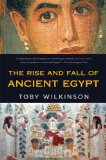Summary | Excerpt | Reviews | Beyond the Book | Readalikes | Genres & Themes | Author Bio

Critics' Opinion:
Readers' Opinion:
First Published:
Mar 2011, 656 pages
Paperback:
Jan 2013, 656 pages
 Book Reviewed by:
Book Reviewed by:
Kevin Bartolotta
Buy This Book
CHAPTER 1
IN THE BEGINNING
The first king of Egypt
In a tall glass case in the entrance hall of the Egyptian Museum in Cairo stands an ancient slab of fine-grained greenish-black stone, about two feet high and no more than an inch thick. Shaped like a shield, it is carved on both sides in low relief. The scenes, though still crisp, are difficult to make out in the diffuse, hazy light that filters down through the dusty glazed dome in the museum ceiling. Most visitors barely give this strange object a second glance as they head straight for the golden riches of Tutankhamun on the floor above. Yet this modest piece of stone is one of the most important documents to survive from ancient Egypt. Its place of honor at the entrance to the Egyptian Museum, the world's greatest treasure- house of pharaonic culture, underlines its significance. This stone is the object that marks the very beginning of ancient Egyptian history.
The Narmer Palette, as it is known to Egyptologists, has become an icon of early Egypt, but the circumstances of its discovery are clouded with uncertainty. In the winter of a.d. 1897-1898, the British archaeologists James Quibell and Frederick Green were in the far south of Egypt, excavating at the ancient site of Nekhen (modern Kom el-Ahmar), the "city of the falcon" (classical Hierakonpolis). The nineteenth century was still the era of treasure seeking, and Quibell and Green, though more scientific in their approach than many of their contemporaries, were not immune from the pressure to discover fine objects to satisfy their sponsors back home. So, having chosen to excavate at Nekhen, a site eroded by countless centuries and largely devoid of major standing monuments, they decided to focus their attentions on the ruins of the local temple. Though small and unimpressive by comparison with the great sanctuaries of Thebes, this was no ordinary provincial shrine. Since the dawn of history, it had been dedicated to the celebration of Egyptian kingship. The local falcon god of Nekhen, Horus, was the patron deity of the Egyptian monarchy. Might the temple, therefore, yield a royal treasure?
The two men worked away, and their initial results were disappointing: stretches of mud brick wall; the remains of a mound, faced in stone; a few worn and broken statues. Nothing spectacular. The next area to be investigated lay in front of the mound, but here the archaeologists encountered only a thick layer of clay that resisted systematic excavation. The city of the falcon seemed determined to keep its secrets. But then, as Quibell and Green struggled their way through the clay layer, they came upon a scatter of discarded ritual objects, a motley collection of sacred paraphernalia that had been gathered up and buried by the temple priests some time in the remote past. There was no gold, but the "Main Deposit"-as the archaeologists optimistically called it-did contain some interesting and unusual finds. Chief among them was a carved slab of stone.
There was no doubt about what sort of object they had found. A shallow, circular well in the middle of one side showed it to be a palette, a grindstone for mixing pigments. But this was no workaday tool for preparing cosmetics. The elaborate and detailed scenes decorating both sides showed that it had been commissioned for a much loftier purpose, to celebrate the achievements of a glorious king. Beneath the benign gaze of two cow goddesses, a representation of the monarch himself-shown in the age-old pose of an Egyptian ruler, smiting his enemy with a mace-dominated one side of the palette. The archaeologists wondered who he was and when he had reigned. Two hieroglyphs, contained within a small rectangular panel at the very top of the palette, seemed to provide the answer, spelling out the monarch's name: a catfish ("nar" in the Egyptian language) and a chisel ("mer"): Narmer. Here was a king previously unknown to history. Moreover, the style of the carvings on the Narmer Palette pointed to a very early date. Subsequent research showed that Narmer was not just an early king; he was the very first ruler of a united Egypt. He came to the throne around 2950, the first king of the First Dynasty. In the mud of Nekhen, Quibell and Green had stumbled upon ancient Egypt's founding monument.
Excerpted from The Rise and Fall of Ancient Egypt by Toby Wilkinson Copyright © 2011 by Toby Wilkinson. Excerpted by permission of Random House, a division of Random House, Inc. All rights reserved. No part of this excerpt may be reproduced or reprinted without permission in writing from the publisher.





The Funeral Cryer by Wenyan Lu
Debut novelist Wenyan Lu brings us this witty yet profound story about one woman's midlife reawakening in contemporary rural China.
Your guide toexceptional books
BookBrowse seeks out and recommends the best in contemporary fiction and nonfiction—books that not only engage and entertain but also deepen our understanding of ourselves and the world around us.